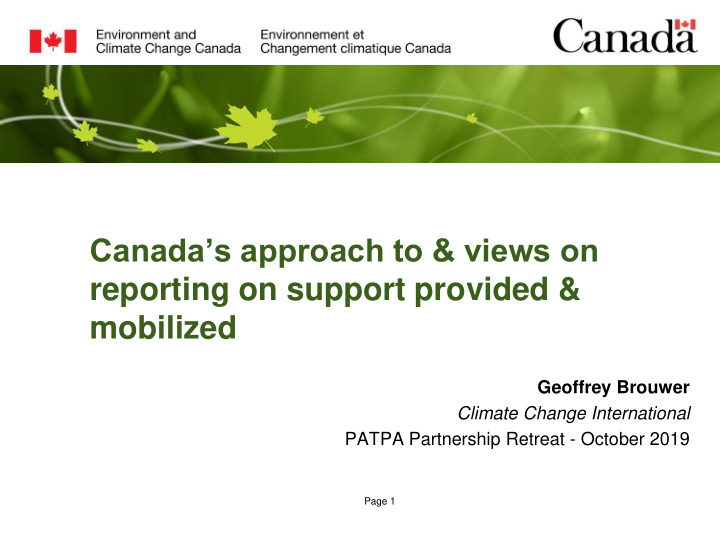



Canada’s approach to & views on reporting on support provided & mobilized Geoffrey Brouwer Climate Change International PATPA Partnership Retreat - October 2019 Page 1
Context: Canada’s Climate Finance • In 2015, Canada announced $2.65 billion in climate financing to help meet the goals of the Paris Agreement – Scaling up to $800 million/year by 2020 – Focused on support for the poorest and most vulnerable countries – Mobilizing private-sector finance for climate action – Delivered through various actors/sources/channels: ▪ Federal departments and agencies ▪ Multilateral partners ▪ Sub-national authorities Page 2
Canada’s Climate Finance Reporting • Canada strives to continually improve our approach to provide a more complete and accurate picture of our climate finance: – Reported on support provided since our first NatCom in 1994 – First used CTFs in our BRs in 2014, 2016, 2018 – Private finance mobilized reported in BR3/NC7 for first time • Currently BR guidelines (19/CP.18) provide strong basis to work from: – Financial support provided (multilateral & bilateral/regional) – CTF 7a, 7b – Tech Transfer Support – CTF 8 – Capacity Building Support – CTF 9 Page 3
Tracking & reporting system Project-level implementation • Project managers (federal agencies, partners) • Tag, collect and report data at the project level Data collection • Global Affairs Canada, other departments • Database, reports to nat’l/int’l audiences UNFCCC reporting • Environment and Climate Change Canada, Natural Resources Canada • UNFCCC reports , climate finance website Page 4
Need for new and updated tables What’s changed? • New MPGs include mandate for new tables: – Support mobilized & support needed and received • More diverse set of actors and donors • International methodologies and standards – OECD’s Technical Working Group (2015) on support mobilized now allows for pro-rated shares • Persistent challenges remain – Better recognition of capacity building and tech transfer objectives – Alignment between donors (fiscal vs. calendar year, methodologies) – Enhanced reporting of private finance mobilized directly attributed to Canada, yet lack of tables – Policy markers as qualitative tags for quantitative reporting Page 5
“Tagging” and tracking of finance 0 2 1 0 2 1 • Canada reports all development assistance using OECD- DAC’s standard policy markers – “cross - cutting” 0 – not targeted – “significant” only 1 – significant 2 – principle Page 6
Summary of Flows and Figures Source: Canada’s BR3/NC7 (2018) Page 7
Key takeaways • Reporting has improved over time, in line with UNFCCC guidelines: – Granularity of info (project level) to enhance transparency ▪ https://climate-change.canada.ca/finance/ – Capture evolving landscape of climate finance – Leveraging international efforts to strengthen our methodologies • Additional work is still needed to improve existing reporting and build new tables, but there exists a strong basis of work in and outside the UNFCCC • Reporting serves variety of purposes and audiences Page 8
THANK YOU! Geoffrey.Brouwer@Canada.ca https://climate-change.canada.ca/finance/ Page 9
Canada’s Climate Finance Website This interactive website provides detailed project level information, including results achieved. Users can search for projects by country, region, priority sector, year, and key word . Page 10 – October 24, 2019
Recommend
More recommend